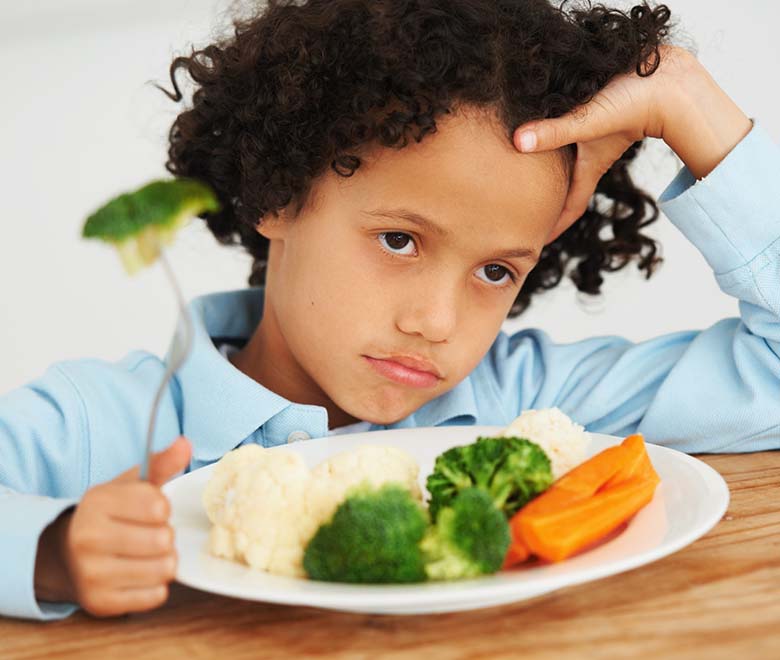
Tips for Moms of Picky Eaters, from Moms of Picky Eaters


Once upon a time, I knocked myself out trying to introduce new food items to my three boys, and when I say I knocked myself out, I mean that almost literally. I always ended up banging my head against the kitchen wall from frustration as the new foods were turned down, time and time again. Rather than give myself a concussion, one day I just decided that I was only going to fix the boys what I was sure they would eat, and then make sure they ate all of it.
This decision, though it reduced dinnertime stress by roughly 80 percent, came with a price. Now I have to ignore the eyebrow raises and commentary from onlookers whose kids “always eat whatever’s served or else they go hungry.” It’s also restricted what restaurants our family can go to (basically only pizza places, but the pizza places HAVE to also serve chicken nuggets for our one non-pizza eater). It means that whenever we go on vacation, or even over to a friend’s house for dinner, I look like I just came from the grocery store with all the food I’m carrying in for my own kids.
It’s ridiculous, and it’s gotten way out of hand. I know this, but I’m not sure what to do about it. That’s why I asked a bunch of moms from all over the U.S. (and some even outside it) what they do to get their picky eaters to try new things. If you’re struggling like I am, there’s bound to be at least one idea here that could help all of us!
Tricks and Treats
Not everyone may approve of trickery or bribing with treats to get their kids to eat, but this is a judgment-free zone. When you’re desperate to get nutrition into your kids, you’ll try anything. These 11 moms are masters in the art of healthy bribery and deception.- I chop spinach and add it to my pasta sauce as "parsley," make chocolate muffins with bananas (they do NOT know the bananas are in there), or I add cauliflower to the mashed potatoes. – Nicole W., Springfield, Illinois
- When my kids were younger, I'd do things like make a meatloaf cake. I would decorate it with mashed potato frosting and mixed vegetable decorations. Pasta sauce is also a great disguise for hiding other puréed vegetables. Dipping sauces and turning items into finger foods usually helps, as do fun shapes! – Helene W., Houston, Texas
- I bribe them with dessert. It probably goes against what the experts say, but the promise of a piece of candy or a cookie usually gets them to at least try new foods and finish their fruit and veggie. – Blogger Kelly from Why did we have to have all these kids anyway?
- I told my daughter, when she was much younger, that asparagus is just "extra-long green beans" and Brussels sprouts are just "baby lettuces." Now, at 12 years old, those two veggies are her favorites. – Angela M., New Orleans, Louisiana
- I read an article a long time ago about how if you call foods by fun names, kids are more likely to eat them. They called carrot sticks X Ray Vision Sticks in a school cafeteria and got twice as many kids to try them! – Blogger from Lurkin’ Mom
- My kids never wanted to eat cauliflower until I told them cauliflower was just white broccoli! – Amy L., Ontario, Canada
- A few tricks with my daughter are to cut her food into different shapes with cookie cutters, put ketchup on the side as a dipping sauce, and I also fib about what is in the meal. She loves pork, but always calls it chicken, so we call it chicken that oinks! After she has eaten the meal and said she liked it, I might reveal it had something in there she didn't like, but I usually don't! – Shannon M., Donnelly, Idaho
- I’ve blogged about how if you serve my kid anything with a Dixie cup and a spork, he’ll eat it. Well, that’s still true. Sometimes I just have to make it fun: toothpicks, dipping things, dividing food up in small cups. It’s exhausting, I know, but it works. – Meredith, blogger at Perfection Pending
- I used to tell my now 13-year-old that salmon cakes were made of dinosaur meat! – Mary Davis W., Moorefield, West Virginia
- I always just put new foods on my kids’ plates without comment. When they asked what it was, I would use a made-up name like “air mountains” for whipped potatoes or “alien tears” for peas. If they didn't eat any that night, I wouldn't make a big deal out of it. I would continue to put it on their plates whenever I made it until, eventually, they tried it. My husband would help by commenting on how good the alien tears tasted that night, and how did I manage to find such yummy ones or some other bit of nonsense. Once you make it more about them missing out on something yummy or even saying something is only for grown-ups, it takes the pressure off. – AnneMarie G., Rocklin, California
- When my oldest was 3, she was having an outright tantrum over peas, and I couldn't take it anymore. I told her if she ate them they would make her laugh. I ate some and began laughing hysterically. It worked, and she laughed through eating them all. We've kept it going since then. She's now 8, and her 5-year-old and 2-year-old brothers still get the giggles sometimes when they eat their peas! – Amber M., Rancho Cordova, California
Thanks, but No Thanks
These four moms believe in having their kids at least try something before turning it away. They require a courteous “no thank you” bite rather than allowing their kids to turn their noses up at the cook. Sometimes, that one bite turns into so many bites that their kids actually finish the meal!- My daughter has to try everything at least once. So we tell her – take one bite, and if you don't like it, tell us what you don't like about it. "It doesn't taste good" or "It's gross" are not acceptable answers; she's 9, so she can tell us what doesn't taste good about it. Then a little later, she has to take at least one more bite, to see if she still feels the same way. If she has a valid reason for not liking it, doesn't put up a fight and eats EVERYTHING else, she doesn't have to finish whatever it is she doesn't like.– Amy M., Farmington, New Hampshire
- We always had a "No Thank You Taste" rule. They had to take a bite and chew it and swallow (no spitting into the napkin). At that point they could say "No thank you." Often times they discovered that it wasn't so bad after all. It also helped them when they went to other people's houses for dinner. They looked more polite and could suck it up for a bite or two. Learning to suck it up is a life skill that starts at the dinner table. – Blogger from Magnificence in the Mundane
- I raised eight kids and was a nanny over the years to others. When trying new foods, my rule is, "Take one bite for every year old you are. If you choose not to, there will be NO dessert and NO snacks later. I'm also certain you don't want warmed up (insert food item) for breakfast. It won't taste as good as waffles." – Opah B., Ithaca, Michigan
- I taught kindergarten, and I gave out the "I tried it award" to anyone who brought a note from home that discussed the new item and the story of how they tried it. I made it clear that they didn't have to like it to get the award. Just try it. The parents thanked me, and the kids were very proud. – Janice C., North Royalton, Ohio
- When my kids started eating table food, my husband (a semi-picky eater) promised me that he would eat whatever was on the table. If the kids were expected to try it, he would too. If we don't eat it, why should they? Now, the kids eat all kinds of things and my husband's palate has expanded too! Our family lived in South Korea for a while and our kids were willing to try all kinds of things because of the foundation laid. It's all worth it! – Jessica K., Eagan, Minnesota
Top Chefs
These moms involve their kids in the shopping and food prep process and say that it makes all the difference. (I actually tried this with my seven-year-old twins to get them to try spaghetti last week, and it worked. They tried it, but they didn’t love it. Please tell me, what kid doesn’t eat spaghetti?!)- Have your kids help with menu planning, shopping, prep, cooking and serving of the meals. The more you engage the eaters in the entire process of obtaining and preparing food, the more likely they are to eat different things. – Pattie, blogger at Bitter Ex-Nuke Wife
- To get our four daughters to try new foods, I brought them to the grocery store every Friday. Each had to pick a new food and then the others had to at least try it. – Cynthia G., Downingtown, Pennsylvania
- My kids were much more likely to eat something they weren't keen on if they helped make it, even when they were little. I would find that it might be something they wouldn't normally eat, but if they had prepared it, and we made a big deal out of how they helped make dinner when we were at the table, they would proudly eat it. Other things – always introduce a new food multiple times, sometimes it takes more than one try for their palate to adjust. – Sarah S., Brisbane, Australia
- I let my kids help with the meals sometimes. They're usually way more excited to try something that they made with their own hands. – Tera B., Ashland, Virginia
- My kids (4 and 6 years old) watch cooking shows with me, and they (especially my 4-year-old son) asks about different recipes and if we have the ingredients to make them. He also is more interested and looks for new foods in the grocery store. – Beth P., Williamsville, New York
- Teaching your kids to cook does help their eating habits, but it can also backfire on you. My 10-year-old is now a great cook but also a tough critic. We recently spent a week visiting my parents, and after several days of watching my mom make supper, he asked why she never learned to cook. – Sarah C., Jefferson, Wisconsin
Sugar, Spice and Everything Nice
My grandma always put a little sprinkle of sugar on things like sliced tomatoes and cucumbers to get my sister and I to eat them, so I do the same with my boys. They absolutely refuse to eat the tomatoes (too squishy!), but they love cucumbers with a very light smattering of sugar. The following ladies had the same idea and took it a few steps further!- We try different spices. Pumpkin pie spice on sweet potato; cumin on corn; mild curry on chicken. Sometimes unexpected flavor is interesting enough for a second or third taste. – Leah C., Knoxville, Tennessee
- A sprinkle of brown sugar is my best friend. Asparagus? I fry it in a little bit of butter sprinkled with brown sugar. They devour it! Oh, and gravy! You can smother lots of things in gravy. – Donlyn J., Hartland, Maine
- Sprinkle spices on foods they already love. You can start this when your kids are babies! If you gave birth to a banana lover, try sprinkling a light dusting of ground cinnamon over the top of his diced/mashed banana. Once he’s comfortable with that, try serving banana with ground nutmeg or ground cardamom over top. Rotate how you serve the bananas—one day with cinnamon, one day with nutmeg, another day with cardamom, and some days, just plain ol’ banana! Doing so carefully exposes your child to different flavors, and the next time he tastes cinnamon, nutmeg or cardamom in a different food, he will likely be more accepting of the flavors, because you’ve made them familiar to him. – Blogger at What A Good Eater
Sensory Challenges
There is a difference between picky eaters and children who have what’s known as Sensory Processing Disorder (SPD). SPD occurs when the brain has trouble processing information through the senses. SPD exists on a spectrum, and is common in kids with autism or ADHD, but it affects many other young kids – up to 16 percent of school-age children in the United States. Most kids with SPD are picky eaters and orally defensive when dealing with the taste, smell, sound and texture of food. How can you tell if your child is just being finicky or if he/she could have an issue? "Eating fewer than 10 foods and really struggling to try new foods is beyond being picky and a red flag for a problem eater," says pediatric dietitian Jessica Crandall, RDN (from Food and Nutrition). The following three moms talk about ways they’ve circumnavigated their child’s sensory challenges.- Things that have worked with my son (some weeks, I practice with rigor and other weeks, not at all) are limiting snacks after school, so that he is really hungry by dinnertime. I sometimes put a plate of raw veggies on the table right before dinner (my kids are much more likely to eat raw stuff). When all else fails: psychological warfare. "That's special for the grown-ups, but you are welcome to try it," always piques interest! – Elizabeth S., Richmond, Virginia
- We found this station on YouTube, All 4 Tube Kids, which has fun food challenges done by kids. My son is delayed with auditory processing, and sensory issues are huge. He gets nauseated just watching other people brush their teeth. But these videos got him to try new foods this year. – Kristi from the blog, Finding Ninee
- I have sensory kids, so most "get picky eaters to eat" rules don't apply. Their will is strong! That said, introducing new foods outside of mealtime has occasionally been successful. As in, don't introduce a new food at dinnertime. Instead, do it on a Tuesday afternoon or a Sunday morning. You'd be surprised at how much anxiety kids develop at prescribed mealtimes. Catch them off guard, and you have a fighting chance at success. – Jennifer from The Runaway Mama
